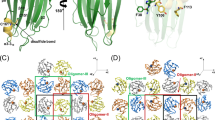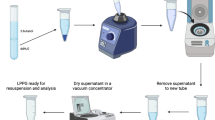Abstract
The extracellular hemolysin fromGardnerella vaginalis (GVH) was purified 88-fold and partially characterized. SDS-polyacrylamide gel electrophoresis (SDS-PAGE) revealed a molecular weight of 59 kD. The hemolysin is most active at pH 6. The mechanism of hemolysis involves one temperature-dependent binding step followed by cell lysis. GVH does not act like an enzyme but is firmly bound to the erythrocyte membrane and used up during the reaction. Osmotic protectants like sucrose and dextran 4 (4000–6000 D) do not protect the toxin-treated erythrocytes from lysis, but dextran 8 (8000–12,000 D) provides full protection. GVH is inactivated by cholesterol,α- andβ-glucosidase. A partial inactivation was found withα-mannosidase and N-acetylglucosaminidase. Human lymphocytes are about 100 times less susceptible than human erythrocytes. The specificity of GVH to human erythrocytes is very high. Red cells from monkey, horse, cow, sheep, and rabbit show less than 1% of human erythrocyte susceptibility.
Similar content being viewed by others
Literature Cited
Amsel R, Totten PA, Spiegel CA, Chen KCS, Eschenbach D, Holmes KK (1983) Nonspecific vaginitis. Am J Med 74:14–21
Balsdon MJ (1982)Gardnerella vaginalis and its clinical syndrome. Eur J Clin Microbiol 1:288–293
Bhakdi S, Muhly M, Füssle R (1984) Correlation between toxin binding and hemolytic activity in membrane damage by staphylococcalα-toxin. Infect Immun 46:318–323
Bhakdi S, Roth M, Sziegoleit A, Tranum-Jensen J (1984) Isolation and identification of two hemolytic forms of streptolysin-O. Infect Immun 46:394–400.
Bhakdi S, Mackman N, Nicaud J, Holland IB (1986)Escherichia coli hemolysin may damage target cell membranes by generating transmembrane pores. Infect Immun 52:63–69
Boyum A (1968) Isolation of mononuclear cells and granulocytes from human blood. Scand J Clin Lab Invest 21 (Suppl. 97):77–89
Bradford MM (1976) A rapid and sensitive method for the quantitation of microgram quantities of protein utilizing the principle of protein-dye binding. Anal Biochem 72:248–254
Cherwonogrodzky JW, Clark AG (1982) The purification of the Kanagawa hemolysin fromVibrio parahaemolyticus. FEMS Microbiol Lett 15:175–179
Eschenbach DA, Hillier S, Critchlow C, Stevens C, Derouen T, Holmes KK (1988) Diagnosis and clinical manifestations of bacterial vaginosis. Am J Obstet Gynecol 158:819–825
Gardner HL, Dukes CD (1955)Haemophilus vaginalis vaginitis. A newly defined specific infection previously classified “nonspecific vaginitis.” Am J Obstet Gynecol 69:962–976
Geoffrey C, Gaillard J, Alouf JE, Berche P (1987) Purification, characterization, and toxicity of the sulfhydryl-activated hemolysin listeriolysin O fromListeria monocytogenes. Infect Immun 55:1641–1646
Gonzales-Carrero MI, Zabala JC, de la Cruz F, Ortiz JM (1985) Purification ofα-hemolysin from an overproducingE. coli strain. Mol Gen Genet 199:106–110
Gray LD, Kreger AS (1984) Purification and characterization of an extracellular cytolysin produced byVibrio vulnificus. Infect Immun 48:62–72
Greenwood JR, Pickett MJ (1979) Salient features ofHaemophilus vaginalis. J Clin Microbiol 9:200–204
Hammann R, Kronibus A, Lang N, Werner H (1987) Quantitative studies on the vaginal flora of asymptomatic women and patients with vaginitis and vaginosis. Zbl Bakt Hyg A 265:451–461
Hill LHU (1985) Anaerobes andGardnerella vaginalis in nonspecific vaginitis. Genitour Med 61:114–119
Jorgensen SE, Hammer RF, Wu GK (1980) Effects of a single hit from the alpha hemolysin produced byEscherichia coli on the morphology of sheep erythrocytes. Infect Immun 27:988–994
Kanclerski K, Möllby R (1987) Production and purification ofStreptococcus pneumoniae hemolysin (pneumolysin). J Clin Microbiol 25:222–225
Laemmli UK (1970) Cleavage of structural proteins during the assembly of the head of bacteriophage T4. Nature 227:680–685
Nomura S, Fujino M, Yamakawa M, Kawahara E (1988) Purification and characterization of salmolysin, an extracellular hemolytic toxin fromAeromonas salmonicida. J Bacteriol 170:3694–3702
Schickle H, Theßeling G, Westermeier R (1989) Qualitative und quantitative Analyse von Proteinen mit der horizontalen SDS-Polyacrylamid-Gradientengel-Elektrophorese. Pharmacia SD RE-58:1–15
Sears DA, Weed R, Swisher SN (1964) Differences in the mechanism of in vitro immune hemolysis related to antibody specificity. J Clin Invest 43:975–985
Spiegel CA, Amsel R, Eschenbach D, Schoenknecht F, Holmes KK (1980) Anaerobic bacteria in non-specific vaginitis. N Engl J Med 303:601–607
Stephen J, Pietrowski RA (1986) Bacterial Toxins. Washington: American Society for Microbiology, pp 74–77
Tanke HJ, van der Linden PWG, Lankerak J (1982) Alternative fluorochromes to ethidium bromide for automated readout of cytotoxicity tests. J Immunol Methods 52:91–96
Werner H (1973) Experimentelle Infektionen durch Bakteroidazeen. In: Eichler O (ed) Handbuch der experimentellen Pharmakologie, Band VII/IIB. Berlin, Heidelberg, New York: Springer Verlag, pp 185–229
Zwadyk P, Snyder JR, IS (1971) Purification and kinetic studies of the hemolysin fromEscherichia coli. Can J Microbiol 17:741–745
Author information
Authors and Affiliations
Rights and permissions
About this article
Cite this article
Kretzschmar, U.M., Hammann, R. & Kutzner, H.J. Purification and characterization ofGardnerella vaginalis hemolysin. Current Microbiology 23, 7–13 (1991). https://doi.org/10.1007/BF02092302
Issue Date:
DOI: https://doi.org/10.1007/BF02092302




